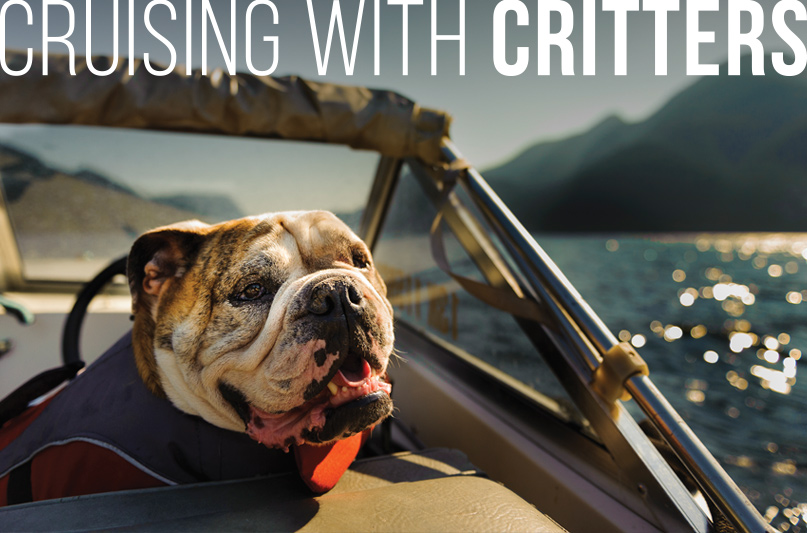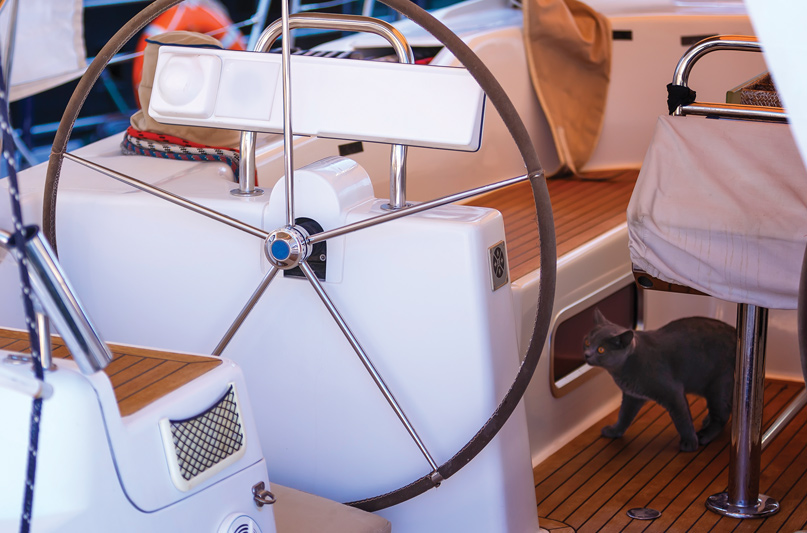
 Kip McSnip, an apricot-colored Border collie mix, and I spent 16 years cruising the waters of the Pacific Northwest, Mexico, and the South Pacific. He was my best mate and best friend. Over the years and the nautical miles, we met countless captains who sailed with animal companions.
Kip McSnip, an apricot-colored Border collie mix, and I spent 16 years cruising the waters of the Pacific Northwest, Mexico, and the South Pacific. He was my best mate and best friend. Over the years and the nautical miles, we met countless captains who sailed with animal companions.
Not just cats and dogs mind you, but every sort of creature from ferrets to parrots to a pot-bellied pig. We met a couple who kept a fishbowl onboard and a family who traveled with lizards, and even watched monkeys swing from the rigging. All these critters were beloved buddies who added challenges and great joy to the adventures of their human friends.
If you’re planning to boat with your furry pals this season you may want to devote some prep time to ensure their comfort and safety aboard. Here are a few tips that will ease your challenges and increase everyone’s fun. For the sake of length, we’ll stick to cats and dogs for the moment.
Six common areas of concern to pet owners are: boarding from the dock and dinghy, going potty onboard, safety issues, provisioning for pets, dealing with anxious pets, and legal issues. We’ll discuss these and offer suggestions to help you easily deal with each.
Boats with swim steps offer effortless access, but boarding vessels with a high freeboard can be more challenging. Luckily, three simple devices make boarding a breeze: boarding steps, folding ramps, and slings.
The first and most obvious solution is a set of boarding steps. Models include solid or open staircases as well as units with built-in storage compartments. These are great at the dock but are too large and clunky to carry onboard.
Another option is a set of folding steps. Specially designed to assist geriatric or handicapped dogs, folding steps are constructed of heavy-duty plastic or aluminum and collapse for easy storage. Downsides are that many models have weight restrictions of 120-150 pounds, which means your pooch may use them without a problem, but they won’t be helpful for many of your adult two-legged crew members.
Also, while they do collapse flat, they are still bulky enough to pose a storage issue.

Below: Some cats take to boats quite naturally, but the location of the litter box may require some innovation.
Lower Puget Sound has 1,300 miles of complicated shoreline, pinching and redirecting an average of 1.3 cubic miles of salt water on each tidal exchange, most of it running through Admiralty Inlet. Take a moment and look at a chart of Puget Sound. Go on, I’ll wait.
A more portable, and practical, solution is a folding ramp. Many of these ramps weigh less than 10 pounds and fold flat to a length of about three feet. Most models are robust and support up to 500 pounds. Small garden carts and dock carts can be rolled up the ramp to the boat’s deck. Because ramps are constructed of heavy-duty plastic and collapse flat, they will conveniently stow on deck and out of the way.
As seasoned boaters know, every item worth its salt should have at least two functions. Folding ramps serve at least three, maybe four. One, they make it easy for you to get on and off your boat even with a small cart. Two, when lashed on deck they provide a rigid surface giving excellent support for fuel cans or other equipment. Three, you can wedge a folding ramp into your companionway to help an older or heavier dog get up to deck level.
Finally, many models come with removable legs, which allow you to turn your ramp into a portable seven-foot buffet table. Even on a budget, a heavy-duty plastic folding ramp will be money well spent.
Steps and ramps make it simple to board from the dock, and small critters can be carried onboard but what about boarding a large dog from a dinghy several feet below deck?
Kip could climb the swim ladder directly from the sea to the deck where he’d shake off and trot over to a favored cushion for an after-swim snooze. But if your dog isn’t a climber, here’s a solution. Slings designed to lower search and rescue dogs from helicopters work well to pull animals up from rocking skiffs. Fit your pooch into the secure sling and then attach the sling to your man-overboard pulley system onboard. The entire process is quick, simple, and safe.
Potty time for your dog won’t be a problem if you make short hops or day trips, but what if you plan to venture farther and stay out longer? While it’s easy to train a puppy to go onboard, older dogs view the boat as their “home” and are more reluctant to use the deck.
Among the many suggested methods for dealing with this issue are using potty-training sprays and pads (best for puppies), placing chunks of sod in a box on deck, and dropping a clump of your buddy’s feces onboard for him to sniff.
None of these methods worked for us.
After a great deal of trial and error, I just sailed away from land with Kip and waited things out. When he finally did go, I rewarded him with loads of love and treats and put a square of artificial grass on “his spot.” After that, whenever we were unable to take him ashore, he went straight to that place without an issue.
If you plan to do extensive cruising with your cat, you may find it worthwhile to devote a small closet (under the head basin works well) for a litter area. Cut a hole in the door several inches from the floor and fix a dowel across the opening. Hang a curtain on the dowel to give your cat easy access while at the same time keeping your head looking clean. Cover the closet floor with artificial grass to catch litter from your cat’s paws. A higher walled box will also help contain the litter.
A hint about litters: the brands made from corn absorb quickly, clump easily, reduce odors, and are lighter in weight than crushed clay. For long trips, take enough litter to last the entire time. Don’t use sand from the beach as it contains all sorts of nasty unwanted things—living and dead—that you seriously do not want on your boat.
Handle dog and cat waste just as you would any other trash on your vessel. Deposit it into baggies and dispose of them properly back on land.
While it’s easy to find a cheeseburger in paradise, it might be a bit harder to locate your pet’s favorite meal. To ensure you have a ready supply onboard, store dry kibble in Tupperware-type boxes and secure the lids with duct tape. Slip a couple of bay leaves into the batch to keep bugs away but be careful your pet doesn’t ingest the herbs.
You pack chocolate for your human crew, right? Be sure to remember to take a supply of your pet’s favorite treats aboard. A little indulgence makes even the roughest ride more pleasant.
In addition to provisioning for the daily needs of your pet, consider stocking your ditch bag with critter-specific items. Include a harness and leash, artificial grass (gives grip in a slippery life raft and provides an emergency potty), a muzzle for your dog as even mellow animals may snap or bite in scary situations, extra water, kibble, and treats. Laminate copies of vaccination papers, color photos of your pet, his chip number, and the numbers of people to contact in case you and he get separated.
Just as PFDs are a must for your two-legged crew, your pet should also be equipped (and wearing) a PFD at all times onboard. PFDs will help your little buddies stay afloat in the case of “a pet overboard,” they give you a handle to grab, and in our chilly Northwest waters, they add a layer of warmth. Purchase a model with padding that covers your pet’s midsection completely.
Avoid models that attach with straps around the belly as these are uncomfortable and can slip out of position.

If you attach a leash to the boat to keep your pet onboard, be sure to measure the distance across the deck to ensure your pet can’t slip over the side while leashed.
Although cats generally don’t care for dips in the water, most instinctively know how to swim. However, the shock of cold water and a swallow of salt water can lower a cat’s ability to react quickly. Hopefully, if your kitty goes overboard, she’ll be wearing her PFD and you’ll be able to grab the handle and scoop her up immediately. But if that’s not the case, or you’re not around, you can help her climb back onboard with the use of a thick rope hung at the stern and another at the bow. Of course, this is only done when your vessel is at anchor or dock—not underway.
Knot the rope every foot and weigh it down so it hangs straight into the water and doesn’t float. Give your kitty a couple of practice sessions by taking her for a dinghy ride to each rope—no need to dunk her in the water for this exercise. Hold her next to the knotted line; she will quickly get the idea of climbing back up to the deck. Do this several times, and soon your cat will…ahem, know the ropes.
Some pets take to the water and the boating experience with ease, but for others, the movement of the boat and the rumble of a big engine can cause alarm and anxiety. Homeopathic remedies such as Rescue Remedy Pet (a non-alcohol-based version of the original Rescue Remedy) are helpful to calm jitters. However simple tricks used to combat seasickness are also effective.
Make sure your pet eats before going out—not a lot, but enough to steady a rolling tummy. Brew a pot of tea with ginger, let it cool, and pour it onto his kibble or a yummy treat. Ginger tea also reduces seasickness and calms anxiety in the human crew.
Gingered candy is great for humans, but the sugar makes it ill-advised for pets. However, ginger snaps (using molasses not white sugar), make a calming and delicious treat for both two-legged and four-legged crew.

Raw honey drizzled on a treat works well although do not give honey to a person or pet with a heart condition. Fenugreek and peppermint teas work much like ginger, and these teas lend a pleasant aroma to the galley.
To help your kitty deal with jitters, make sure she has a dark, quiet place to hide. My cat likes to snuggle into towels in the forward head compartment. Okay, a few cat hairs in the bath towels, but well worth our mellow, happy critter.
The rules and regulations on crossing international borders with pets are moving targets. If you plan to cross an international border with your pet, look at the country’s website before heading out.
However, an easy rule of thumb is that island nations—British Virgin Islands, French Polynesia, Australia, New Zealand, etc.—have tighter laws about pet importation because of the fear of rabies, while countries such as Mexico, the United States, and Canada are more relaxed in their laws around domestic pets.
Canada, for example, requires that kittens and puppies over eight months be fully vaccinated—owners wishing to cross the Canadian/U.S. border should bring proof of vaccination. Although micro-chipping is not required, much like spaying and neutering, it’s something responsible pet owners do for the safety and well-being of their animals.
In conclusion, with some advanced planning and patience, you’ll discover that cruising with critters can be one of the most rewarding and joyful parts of your boating adventures!